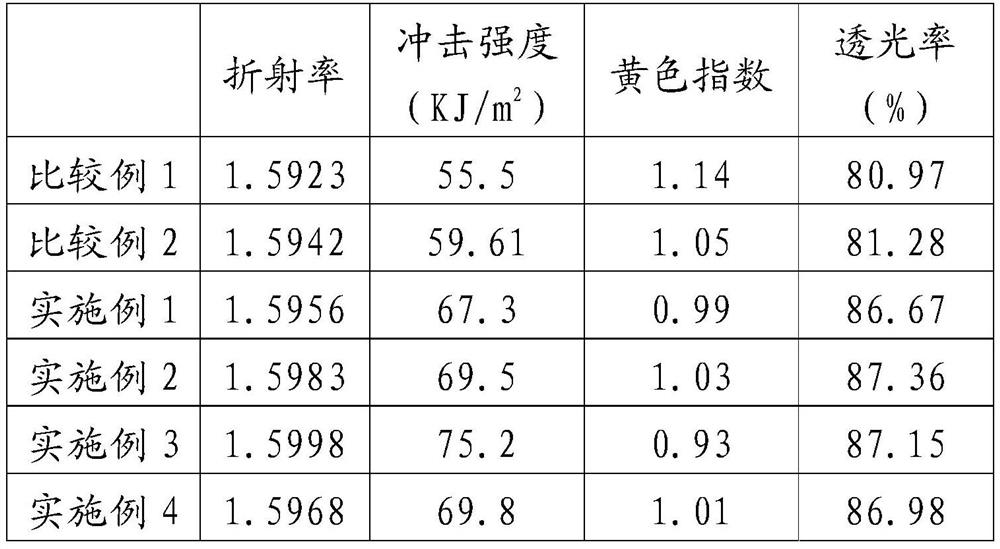A kind of optical resin composition, optical resin material and application thereof
An optical resin and composition technology, applied in optics, optical components, instruments, etc., can solve the problems affecting the quality of finished lenses, and achieve the effects of excellent appearance, high impact strength, and moderate refractive index
- Summary
- Abstract
- Description
- Claims
- Application Information
AI Technical Summary
Problems solved by technology
Method used
Image
Examples
Embodiment 1
[0045] Preparation of amine compounds:
[0046] Halogenation reaction---Dissolve 5g of dipentaerythritol (Bailingwei) in a flask filled with 100ml of ethanol, add 5.06g of halogenating agent NaBr (Alfa Aesar) dropwise into the flask in an oil bath at 25°C, and put the oil bath The temperature was raised to 170°C, and at the same time, the stirring was started, and after stirring for 20 hours, the product was obtained by rotary evaporation and drying;
[0047] Ammonolysis reaction---Dissolve the obtained 6.2g product (0.012mol) in a flask filled with 100ml methanol and 0.5g ammonium chloride (Hunan Jianghe Environmental Protection Industry), and add 25wt% concentration of chloroformate in three times under the protection of nitrogen atmosphere. A total of 14.5 g (0.104 mol) of ammonia water was raised to 150°C and stirred for 24 hours. After extracting, rectifying and drying, the final amine compounds are obtained.
[0048] Preparation of optical resin materials:
[0049] Ta...
Embodiment 2
[0051] Preparation of optical resin materials:
[0052] Take 11g of isophorone diisocyanate, 15g of dicyclohexylmethane diisocyanate, add 0.75g of the amine compound prepared in Example 1 and 0.02g of catalyst triethylenediamine (Hubei Chushengwei Chemical Industry Co., Ltd.) , 0.015g internal release agent di-n-butyl phosphate (Hangzhou Dayang Chemical Industry) and 0.025g ultraviolet absorber 2-(2H-benzotriazol-2-yl)-4-methylphenol (Hubei Guangao Biotechnology ), fully dissolved to obtain solution A. Weigh 5 g of bis(mercaptoethyl) sulfide (Bainwei) and 15.4 g of pentaerythritol tetrakis(3-mercaptopropionate) (Jingbo) and mix them uniformly to obtain component B. The two components A and B are mixed at 25°C, and the uniformly mixed liquid is defoamed at 600Pa for half an hour, and then filtered through a 1μm PTFE filter. The filtered combination liquid is poured into the mold, heated from 25°C to 115°C for 16 hours to heat and solidify, and finally the product is obtained ...
Embodiment 3
[0054] Preparation of optical resin materials:
[0055]Take 30g of toluene diisocyanate, add 1.1g of the amine compound prepared in Example 1, 0.025g of the catalyst di-n-butyltin dichloride (Bailingwei), 0.01g of the internal release agent acid butoxyphosphate at 25°C ethyl ester (Shanghai Gaoming Chemical) and 0.025g of UV absorber 2-(5-chloro-2H-benzotriazol-2-yl)-4-methyl-6-tert-butylphenol (BASF), fully Dissolving to obtain solution A. 6.9g of trimethylolpropane tris(2-mercaptoacetate) (Hubei Shengtian Hengchuang) and 13.4g of pentaerythritol tetrakis(2-mercaptoacetate) (Shanghai Longsheng Chemical Industry) two kinds of polythiols were stirred to mix uniformly, Obtain the B component. The two components A and B are mixed at 25°C, and the uniformly mixed liquid is defoamed at 600Pa for half an hour, and then filtered through a 1μm PTFE filter. The filtered combination liquid is poured into the mold, heated from 28°C to 110°C for 20 hours to heat and solidify, and final...
PUM
| Property | Measurement | Unit |
|---|---|---|
| density | aaaaa | aaaaa |
| impact strength | aaaaa | aaaaa |
Abstract
Description
Claims
Application Information
 Login to View More
Login to View More - R&D
- Intellectual Property
- Life Sciences
- Materials
- Tech Scout
- Unparalleled Data Quality
- Higher Quality Content
- 60% Fewer Hallucinations
Browse by: Latest US Patents, China's latest patents, Technical Efficacy Thesaurus, Application Domain, Technology Topic, Popular Technical Reports.
© 2025 PatSnap. All rights reserved.Legal|Privacy policy|Modern Slavery Act Transparency Statement|Sitemap|About US| Contact US: help@patsnap.com


